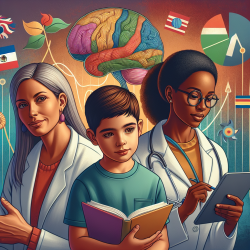Introduction
As a speech-language pathologist, understanding the intricate connections between various developmental disorders is crucial for crafting effective intervention strategies. Recent research has shed light on a fascinating link between tone-deafness, also known as congenital amusia, and prosopagnosia, a disorder characterized by difficulties in recognizing faces. This blog will explore the key findings from the study titled "Developmental Perceptual Impairments: Cases When Tone-Deafness and Prosopagnosia Co-occur" and discuss how these insights can be applied to improve therapeutic outcomes for children.
Understanding the Research
The study investigated whether congenital tone-deafness and developmental prosopagnosia co-occur, even if subtly. Researchers assessed face perception abilities in a group of tone-deaf individuals compared to non-tone-deaf controls. The results revealed that some tone-deaf individuals also exhibited impairments in face recognition, suggesting a potential co-occurrence of these disorders.
Key findings include:
- Two out of six tone-deaf participants scored in the impaired range on the Cambridge Face Memory Test (CFMT), indicating face recognition difficulties.
- A significant correlation was found between melodic perception scores and face recognition abilities, highlighting a possible link between these perceptual domains.
- The study suggests a common developmental mechanism that might underlie both tone-deafness and prosopagnosia, potentially involving early neural development anomalies.
Implications for Practice
For practitioners working with children, these findings offer valuable insights. Here are some ways to incorporate this knowledge into your practice:
- Comprehensive Assessments: When assessing children with tone-deafness, consider evaluating their face recognition abilities. Early identification of co-occurring disorders can lead to more tailored interventions.
- Interdisciplinary Collaboration: Collaborate with other professionals, such as psychologists and neurologists, to develop comprehensive treatment plans that address multiple developmental challenges.
- Targeted Interventions: Design interventions that simultaneously address musical perception and face recognition skills. For example, integrating music therapy with visual recognition exercises could enhance outcomes.
Encouraging Further Research
While this study provides a foundation for understanding the link between tone-deafness and prosopagnosia, further research is needed to explore the underlying mechanisms and broader implications. Practitioners are encouraged to stay informed about emerging research and consider participating in studies that aim to deepen our understanding of these disorders.
Conclusion
The co-occurrence of tone-deafness and face recognition impairments highlights the complexity of developmental disorders and the need for comprehensive, data-driven approaches in therapy. By integrating these insights into practice, we can better support children in overcoming challenges and achieving their full potential.
To read the original research paper, please follow this link: Developmental Perceptual Impairments: Cases When Tone-Deafness and Prosopagnosia Co-occur.










